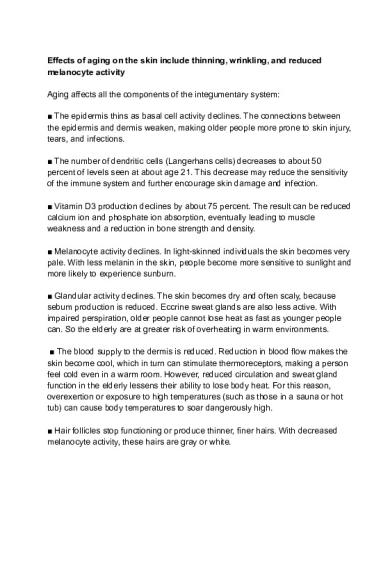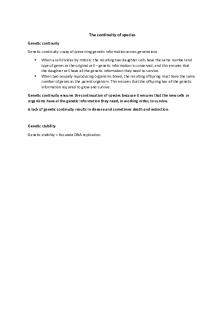Effects of aging on the skin include thinning, wrinkling, and reduced melanocyte activity PDF

| Title | Effects of aging on the skin include thinning, wrinkling, and reduced melanocyte activity |
|---|---|
| Course | Human Anatomy and Physiology with Lab I |
| Institution | The University of Texas at Dallas |
| Pages | 2 |
| File Size | 51.5 KB |
| File Type | |
| Total Downloads | 102 |
| Total Views | 131 |
Summary
Effects of aging on the skin include thinning, wrinkling, and reduced melanocyte activity...
Description
Effects of aging on the skin include thinning, wrinkling, and reduced melanocyte activity Aging affects all the components of the integumentary system: ■ The epidermis thins as basal cell activity declines. The connections between the epidermis and dermis weaken, making older people more prone to skin injury, tears, and infections. ■ The number of dendritic cells (Langerhans cells) decreases to about 50 percent of levels seen at about age 21. This decrease may reduce the sensitivity of the immune system and further encourage skin damage and infection. ■ Vitamin D3 production declines by about 75 percent. The result can be reduced calcium ion and phosphate ion absorption, eventually leading to muscle weakness and a reduction in bone strength and density. ■ Melanocyte activity declines. In light-skinned individuals the skin becomes very pale. With less melanin in the skin, people become more sensitive to sunlight and more likely to experience sunburn. ■ Glandular activity declines. The skin becomes dry and often scaly, because sebum production is reduced. Eccrine sweat glands are also less active. With impaired perspiration, older people cannot lose heat as fast as younger people can. So the elderly are at greater risk of overheating in warm environments. ■ The blood supply to the dermis is reduced. Reduction in blood flow makes the skin become cool, which in turn can stimulate thermoreceptors, making a person feel cold even in a warm room. However, reduced circulation and sweat gland function in the elderly lessens their ability to lose body heat. For this reason, overexertion or exposure to high temperatures (such as those in a sauna or hot tub) can cause body temperatures to soar dangerously high. ■ Hair follicles stop functioning or produce thinner, finer hairs. With decreased melanocyte activity, these hairs are gray or white.
■ The dermis thins, and the elastic fiber network decreases in size. As a result, the integument becomes weaker and less resilient, and sagging and wrinkling occur. These effects are most noticeable in areas of the body that have been exposed to the sun. ■ With changes in levels of sex hormones, secondary sexual characteristics in hair and body fat distribution begin to fade. ■ Skin repairs proceed more slowly. Repairs to an uninfected blister might take three to four weeks in a young adult, but the same repairs could take six to eight weeks at age 65–75. Because healing takes place more slowly, recurring infections may result....
Similar Free PDFs

THE EFFECTS OF CORRUPTION
- 5 Pages

Effects of internet on society
- 3 Pages

Effects Of Sitcoms On Teenagers
- 6 Pages

Eating disorders and the skin
- 6 Pages

Accessory Organs of the Skin
- 4 Pages

Theories of Aging
- 2 Pages

Effects of the Sugar REvolution
- 4 Pages
Popular Institutions
- Tinajero National High School - Annex
- Politeknik Caltex Riau
- Yokohama City University
- SGT University
- University of Al-Qadisiyah
- Divine Word College of Vigan
- Techniek College Rotterdam
- Universidade de Santiago
- Universiti Teknologi MARA Cawangan Johor Kampus Pasir Gudang
- Poltekkes Kemenkes Yogyakarta
- Baguio City National High School
- Colegio san marcos
- preparatoria uno
- Centro de Bachillerato Tecnológico Industrial y de Servicios No. 107
- Dalian Maritime University
- Quang Trung Secondary School
- Colegio Tecnológico en Informática
- Corporación Regional de Educación Superior
- Grupo CEDVA
- Dar Al Uloom University
- Centro de Estudios Preuniversitarios de la Universidad Nacional de Ingeniería
- 上智大学
- Aakash International School, Nuna Majara
- San Felipe Neri Catholic School
- Kang Chiao International School - New Taipei City
- Misamis Occidental National High School
- Institución Educativa Escuela Normal Juan Ladrilleros
- Kolehiyo ng Pantukan
- Batanes State College
- Instituto Continental
- Sekolah Menengah Kejuruan Kesehatan Kaltara (Tarakan)
- Colegio de La Inmaculada Concepcion - Cebu








